Production Notes - GoldenEye
In the fallout from the disappointing box office
returns for "Licence to Kill" [1989]
there was much boardroom politicing and
financial manoeuvring that virtually ensured that James Bond
would be absent from our screen for six years.
Albert
R. Broccoli, disheartened at the way that the Bond franchise
was going, had put Danjaq, the Swiss based parent company
of the
Bond production office, EON, up for sale at the turn of the 90s.
EON itself was passed on to Michael G. Wilson, Broccoli's
stepson
who had been guiding the series as executive producer since "Moonraker"
[1979], and Broccoli's daughter Barbara who had been playing
an
increasingly important role in the last couple of films.
On August 12 1990, The Sunday Times reported that Broccoli had
parted company with Richard Maibaum and John Glen, long serving
writer and director respectively - Maibaum, who had been at least
partly responsible for 13 out of the 16 'official' Bond films
so far, died a year later. Broccoli now set to work seeking out
fresh blood to try to revitalise what was clearly an ailing franchise.
Among those he considered were John Landis, American TV writer
Alfonse M. Ruggiero Jr [though his track record on Miami Vice
and Airwolf hardly boded well], Rambo director Ted Kotcheff, writer
/ director John Byrum and, most worrying of all, husband-and-wife
writing team Gloria and Willard Huyck, the people responsible
for Howard the Duck [1986].
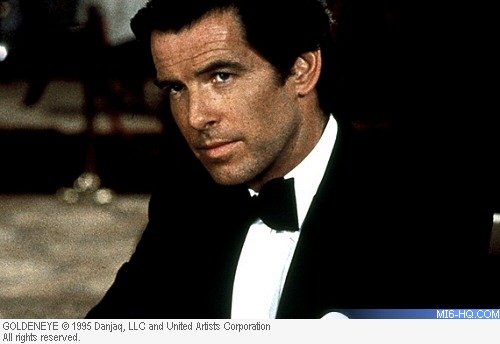
Above: Pierce Brosnan as James
Bond in "GoldenEye".
|
MGM/UA were getting a little desperate at this
point. Bond had been one of the mainstays of their success and
the early 90s were
difficult times - they had only Rocky V ready for release and
that was far from assured of success. They needed Bond, though
even they were forced to admit that "the series is looking
a little tired."
Then things started to get even muddier. In
1989, the MGM/UA chairman had sold the company to the Australian
based broadcasting
group Quintex and they in turn were negotiating to merge the
company with Pathe Communications. Just days before the proposed
merger date on 23 October 1990, Danjaq, still in the control
of Broccoli and his wife Dana, issued a writ against MGM/UA
and its
new chairman, Italian businessman Giancarlo Peretti, trying to
stop the company from licensing the Bond back catalogue to Pathe
Communications for TV distribution deals that were allegedly
unfavourable to Danjaq.
Danjaq was arguing that Pathe had entered into
agreements with Japanese, Spanish, French, Italian and South
Korean broadcasters to show the Bond films on TV but had failed
to consult with Danjaq first. Danjaq's attorney told Variety
that the deals were "improvident in a number of respects.
Their most obnoxious aspect is the length of the terms at ridiculously
low rates." Danjaq alleged that Pathe was going to sell
the TV distribution rights in order to generate the funds it
needed for the proposed buy-out of MGM/UA and Danjaq were rightly
worried that they would be unable to generate income from their
films through TV sales for the rest of the century.
|
In 1992, with the matter still unresolved
and with Broccoli's health failing, a new problem presented
itself - Frank Mancuso had been installed as the chairman
of the newly formed MGM/UA Pathe and he in turn appointed
John Calley as the president of United Artists. Calley had
been at Warner Brothers during the production of Kevin McClory's
rogue Bond picture "Never Say Never
Again" [1983] and on
his appointment was keen to see the 'official' Bond franchise
up
and running again. But he wanted a new Bond and presented
Broccoli with a list of names, among them Hugh Grant [then
still largely unknown], Ralph Fiennes, Liam Neeson and Pierce
Brosnan, all of whom he felt would be worthy of consideration.
But Broccoli was adamant that Timothy
Dalton should
fulfil his three picture contract and remain on as Bond.
In 1993, Broccoli had a victory at last.
Giancarlo Peretti was removed as head of MGM/UA and the incoming
regime seemed more willing to deal with Danjaq on Broccoli's
terms. On 6 August 1993, Timothy Dalton was interviewed by
The Daily Mail and gave the first indication of what was
to come. He claimed that Michael France, who had penned the
Sylvester Stallone thriller Cliffhanger was on board and
working on a screenplay for the forthcoming Bond film. Dalton
hinted that production was set to begin in January or February
of 1994. |
|
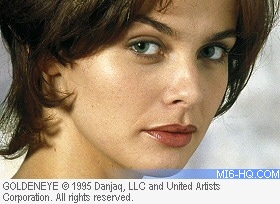
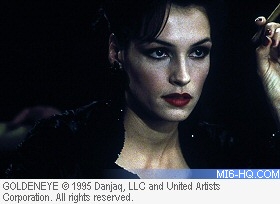
Above: The leading ladies of "GoldenEye" -
Izabella Scorupco (top) as Natalya Simonova and Famke
Janssen as Xenia Onatopp.
|
Satisfied that the franchise
and its history was once again safely in Danjaq's hands, Broccoli
took a back seat and allowed Michael
G. Wilson and
Barbara Broccoli to get on with the day to day running of EON
Productions. Broccoli's health was deteriorating, the producer
plagued by a serious heart condition that was putting great strains
on him.
The January or February 1994 production start that Dalton had
suggested came and went and there was still not even an official
announcement from EON as to where the series was heading. As time
wore on, it became inevitable that patience would be worn thin
and on 12 April 1994, a bombshell was dropped - Timothy Dalton
was refusing to come back to the fold. He'd signed up for three
film, but it was now five years since his last outing as Bond
and he felt the time had come to move on.
|
EON opted not to stand in his way and
set about searching for his replacement. Although ten actors
were screen tested there was really little doubt who was
going to get the role. During the filming of "For
Your Eyes Only" [1981], Broccoli had lunched with one
of the film's
co-stars, Cassandra Harris who had introduced the producer
to her fiance, a handsome young Irish actor by the name
of Pierce Brosnan. Broccoli had been impressed by Brosnan
and, when Roger Moore hung up his tuxedo after "A
View To a Kill" [1985], had sought him out with a view to casting
him as Bond.
But Brosnan had been enjoying some success
on American TV in the comedy-drama Remington Steele. At
first it looked as though the show was being cancelled
by its network, NBC and that Brosnan would be free to accept
Broccoli's offer to join the EON team.
But as the world's
press leaked more information about the new Bond, NBC
changed its mind and asked producers Mary Tyler Moore Television
for another series of Remington Steele and Brosnan, still
under contract, had no choice but to turn down the chance
to play 007. |
|
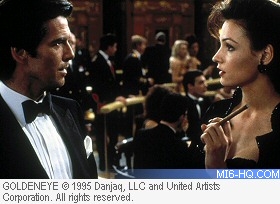
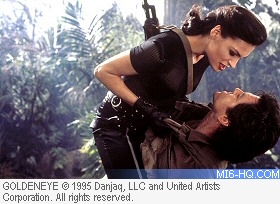
|
But this time, things were different. Remington
Steele had finished its run at the end of 1986 and Brosnan appeared
in a string of
largely undistinguished features and TV films for a few years.
His career went on hold for a while as he nursed Harris through
the final stages of the cancer that was to claim her life in
1991. Brosnan was devastated and it took him some time to turn
his mind
back to his work. More undistinguished films followed, including
"Mister Johnson" [1991] and "The Lawnmower Man" [1992], his
only major
credit during these difficult years being a small part in the
hit Robin Williams comedy "Mrs Doubtfire" [1993]. By 1994, the
time
was right for the talented Irishman's elevation to a loftier
stature and Wilson and Broccoli were quick to snap him up.
Brosnan has frequently recalled how, as a boy
just over from Ireland, he had been to the cinema to see his
first film - "Goldfinger"
[1964]. While shooting "GoldenEye", Brosnan was to keep a copy
of Fleming's Goldfinger
novel at hand, "just for the significance
of it."
Timothy Dalton's assertion that Michael France
was writing the new film proved correct. Working closely with
the Broccoli's and
Wilson, France had created a first draft screenplay named after
Ian Fleming's house in Jamaica, "GoldenEye". The first draft had
been written with Dalton in mind and, when Brosnan came on board,
it was rewritten by British writer Jeffrey
Caine who retained
a lot of France's original ideas [involving Bond's relationship
with the traitorous 006, Alex Trevelyan] but added new angles
to the piece - it was Caine who added the nine-years-previously
prologue that opens the finished film. A third writer, Kevin
Wade,
was brought in to polish the script, followed by final tinkering
by Bruce Feirstein, a friend of Barbara Broccoli and her husband
Fred Zollo. This complex arrangement was acknowledged on-screen
with Caine and Feirstein sharing a screenplay credit while France
was credited with creating the story. There was no on-screen
credit for Wade.
With leading man and script in place, it fell
to EON to now find a suitable director. Albert R. Broccoli's
relationship with John
Glen, who had directed the last five films, had ended in 1990
and the attitude at EON now seemed to be that a complete break
with the past was called for. Various directors were considered
[Roger Spottiswoode, later to direct "Tomorrow
Never Dies" [1997],
claims to have been asked to direct a new Bond film as early
as 1991, even though no script was ready at that stage] before
Wilson
and Broccoli opted for New Zealander Martin Campbell.
|
Campbell had started his career in the
mid-70s directing British sex comedies like "The Sex Thief"
[1973] and the riotous and really rather good "Eskimo Nell"
[1974], a sharp and very funny insight into the slapdash
world of British 70s exploitation cinema. Later, Campbell
moved to TV where he worked on shows like Minder, Shoestring
and The Professionals. 1986 saw him reach his first peak
of creative excellence with the BBC drama Edge of Darkness
and Campbell soon had Hollywood beckoning.
The supporting cast was to be headed by
Sean Bean as the turncoat agent 006, Alex Trevelyan. Best
known as TV's Lieutenant Sharpe in ITV's successful adaptations
of Bernard Cornwell's novels, Bean was offered the part
after he'd auditioned for Bond and lost out to Brosnan.
Polish actress Izabella
Scorupco was the
leading Bond girl, a successful performer, model and singer
on the continent but less well known elsewhere. "GoldenEye"
was her first film in English. The other main Bond girl,
the awesome Xenia Onatopp, was to be played by Famke
Janssen.
The Dutch model-turned-actress was spotted by Wilson in footage
from the then still in production Clive Barker film "Lord
of Illusions" [1995] and her performance in an otherwise
drab and forgettable film so impressed the producers that
she
was offered the part immediately. |
|
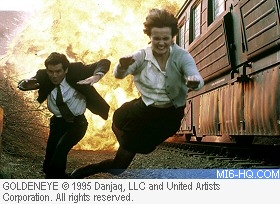
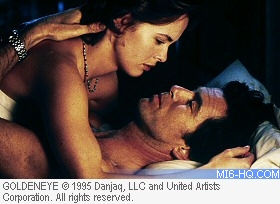
Above: Before "GoldenEye", Izabella
Scorupco was an unknown in Hollywood. She went on to star
in "Vertical Limit" with
director Martin Campbell.
|
Joe Don Baker - on the side
of the enemy in "The Living Daylights"
[1987] - returned to the series as one of Bond's allies, CIA
agent
Jack Wade, clearly intended
as a replacement for Felix Leiter. Baker had worked with Campbell
before, turning in a stunning
performance
as Darius Jedburgh in "Edge of Darkness". Another ally for Bond,
albeit a reluctant one, was Russian gangster Valentin
Zukovsky,
played with gusto by Robbie Coltrane, still riding high after
his success as hard-bitten criminal psychologist Fitz in TV's
Cracker.
Ever willing to keep pace with changing real
world mores and attitudes, "GoldenEye" would see the introduction
of a new M - and
with MI5 now being run by a woman, Stella Rimmington, the inspired
decision was made to cast Judi Dench as Bond's new boss. She
was
to be assisted by the official series' third Moneypenny,
the aptly named Samantha Bond taking over from Caroline Bliss.
Keeping
continuity
alive and well was Desmond Llewelyn returning for his 15th outing
as the ever- exasperated Q.
On 1 June 1994, Pierce Brosnan received the
news he'd been waiting for for almost eight years - he was officially
the next James
Bond. He immediately signed the customary three-picture deal
and was introduced to the press [in the full beard he was sporting
for a forthcoming TV adaptation of Robinson Crusoe] on Wednesday
8th June.
|
The finished screenplay was heartily endorsed
by Campbell, who enthused about its capturing of the spirit
of the earlier films, though his personal dislike of smoking
meant that Bond was to give the habit up again - 007 had
started smoking again when Dalton arrived on the scene,
but EON were clearly uneasy about the image this presented
as they placed a "smoking can kill" warning during
the end credits of "License To Kill" [1989].
With production set to begin, EON hit
a snag. They wanted to return to their traditional home
at Pinewood but the studios had been busier of late than
ever before. By the time "GoldenEye" was ready to roll,
Gerry Anderson's Space Precinct TV show had moved in and
commandeered
most of the available space. And the studios were largely
booked up for the foreseeable future.
EON started scouting round for a new base
of operations. Wilson and Broccoli were keen to stay in
the UK and they were able to achieve this when they happened
upon a huge, abandoned Rolls Royce factory at Leavesdon
Aerodrome near Watford in Hertfordshire. The factory had
closed down in 1993 and the vast buildings, sitting in
150 acres of land, were ideal for EON's needs. Work began
on creating the first new British film studios in decades
and by June 1994, six sound stages were ready for use. |
|
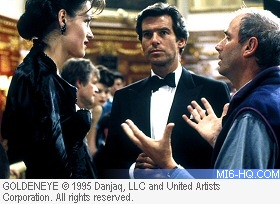
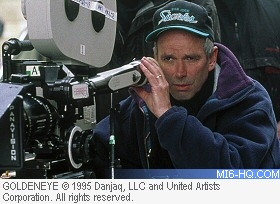
Above: Martin Campbell directs Famke Janssen and Pierce Brosnan
for the casino scene. Campbell would return to the series to
usher in the next Bond, Daniel Craig in "Casino Royale".
|
Production itself began on 16 January 1995 at the newly dubbed
EON Studios at Leavesdon, though the first time the press was
to see the new cast was on Sunday 22 January. A short while later,
the production set out for Monaco to shoot the casino scenes where
Bond first meets Xenia, and the car chase scene that saw the long
overdue return of the Aston
Martin DB5. Down in the harbour, the
yacht Northern Cross stood in for the Manticore in the scene where
Bond realises what Xenia is up to and races against time to prevent
her from stealing the Tiger
helicopter.
The finale, set on Trevelyan's radio-telescope, was filmed at
the famous Arecibo radio telescope in Puerto Rico. Part of SETI
[Search for Extra-Terrestrial Intelligence], Arecibo is the largest
fixed radio telescope in the world and provided a stunning backdrop
for the stunt team's antics. Stunt newcomers Jamie Edgall and
Sean McCabe stood in for Brosnan and Bean during the climactic
hand-to-hand fighting.
The teaser was filmed at the Verzasca Dam in
Locarno, Switzerland. Stuntman Wayne Michaels performed the
spectacular bungee jump
and also did a second, shorter jump for use in close ups. The
interiors of the nerve gas facility were sets specially built
at Leavesden by returning production designer Peter Lamont. Outside,
the old airfield proved to be the perfect location for Bond's
daring escape by motorcycle and aircraft.
The second unit, under the direction of Ian
Sharp, headed off for St Petersburg to spend two weeks shooting
reference footage that was to be carefully matched to a specially
built backlot at Leavesden.
|
When Bond meets Wade at St Petersburg
airport, Epsom race course was pressed into action to double
for the real thing, and the production also revisited the
Nene Valley steam railway [previously used in the making
of "Octopussy" [1983] to shoot the scene aboard Trevelyan's
train.
On 1 June 1995, one year exactly after
he heard that he'd finally got his coveted role, Brosnan
had a surprise visitor on the set at Leavesden. Roger Moore
turned up and announced that he'd been sent to take over!
In fact he was on the set to visit his son Christian who
was keeping it in the family and working as a third assistant
director. Five days later, after filming the St Petersburg
tank chase, principal
photography came to an end on Tuesday 6th June.
The special effects on "GoldenEye" were
to be a mix of traditional model work [created by a unit
headed
by Derek
Meddings] and, making their first appearance in
a Bond film, the new generation of digital effects. "GoldenEye"
was to be Meddings' swan song. Shortly after completing his
work on the eighteenth Bond film, the effects wizard was
to die of cancer. |
|
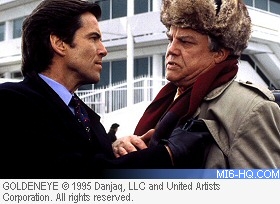
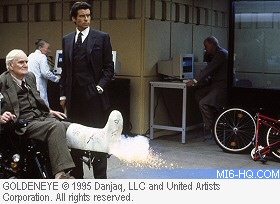
|
While the effects crew were at work, the soundtrack was
being compiled. Unlike earlier films, where a single musical
director,
usually John Barry, had guided the score to its completion. But
on "GoldenEye", at least seven musical talents contributed to
the
finished soundtrack, not necessarily with the desired results.
John Altman and David Arch contributed a symphonic score that
was augmented by a synthesiser score by Frenchman Eric Serra.
The title song was written by Bono and The Edge, singer and
guitarist
respectively with Irish supergroup U2 and had called on top producer
Nellee Hooper to oversee production duties. To actually sing
the
song, they recruited Tina Turner who took the single to number
ten in the British charts. Maurice Binder, the man behind almost
all of the Bond's distinctive title sequences, had died in 1991
and "GoldenEye"s stunning kaleidoscope of symbolism and surrealism
was created by former pop promo director Daniel Kleinman.
"GoldenEye" opened in the States on 17 November
1995 and was an immediate smash hit. Admissions topped 29 million,
the best since
the heyday of "You Only Live Twice" [1967]. It had its British
premiere at the Odeon Leicester Square in the company of the
Prince of
Wales who was reported to have cheered his approval during the
action sequences. The film opened to the public in London on
22
November and went on nationwide release two days later.
"GoldenEye" was a massive success around the world. By May 1996,
just six months after it opened, "GoldenEye" had grossed a staggering
£106,429,941 at the US box office and £350,731,227
worldwide, figures that hadn't been seen since the series was
at its height in the 1960s.
Sadly, some of the shine was taken off Bond's glorious return
when, on 27 June 1996, Albert R. Broccoli died at the age of 87.
He had been ill for a long time, too ill in fact to visit the
set of "GoldenEye", but he kept his finger on the pulse right up
to the end, monitoring the progress of the new film as best he
could.
A memorial service was held, where else but
at the Odeon Leicester Square, scene of so many of Broccoli's
greatest triumphs, on 17
November 1996, the same day that "GoldenEye" opened in the States
a year previous. Roger Moore, Timothy Dalton and Pierce Brosnan
joined friends
and family to pay tribute to a man who had, in his own way, changed
the face of British film history.